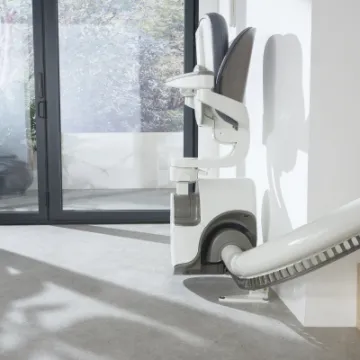Tips For Choosing A Stairlift
When it comes to deciding what stairlift will best suit an end user there is a lot more to consider than just what make and should it be straight or curved. To find out more, we spoke to Andy Musson, Sales Manager from leading stairlift manufacturer Access BDD who has over 32 years' experience in the stairlift industry.
Firstly, we always advise that people look for a supplier that is based locally to them, this ensures that any servicing or maintenance work can be carried out relatively quickly. It is also worth asking to speak to a couple of their previous customers to get their feedback – if they are unwilling to do this, alarm bells should ring immediately.
It is important to remember that no one wants a stairlift out of choice so it can be quite an emotional time for the client as they are admitting they need help to remain independent in the home.
To help make this process as easy as possible, over recent years, R & D and design teams have been doing all they can to make stairlifts as aesthetically pleasing as possible and here at Access BDD we are renowned for leading the way with modern designs that blend into a domestic environment, as well as fulfil practical and legislative requirements.
As a manufacturer we do not sell directly to end users but through a network of carefully selected partners and it is often the case that an Occupational Therapist will be involved in the process especially when there has been a referral from a hospital or local authority.
Alternatively, some people will purchase a stairlift as a 'provision' – they may be noticing their mobility is reducing due to advancing years or an ongoing medical condition and realise the stairs could become an issue in the near future – these are normally privately funded purchases.
Levels of mobility
Assessing the user begins before you even enter the house. Do they have a ramp up to the front door, is there a rail by the front door, can they walk independently – these will immediately give you a feel for their level of mobility. Other things to consider include their eyesight, how stable they are on their feet, when sitting down do they push down a lot or lean to one side and how easily can they transfer from one chair to another, especially if they use a wheelchair or walker around the house. Should the user be exceptionally tall, or have limited flexion, we can rotate the seat, so they go up the stairs at an angle.
Depending on the design and width of the staircase, a straight or curved lift can normally be fitted, there is usually a way to accommodate even the most complex staircase. It is also vital to consider the household, other stair users; for example, fitting a stairlift track to the narrow part of a fan, so pedestrians can use the wider steps.
As the name suggests, a straight stairlift goes in a straight line so the chair will terminate over the top step, and by the bottom of the stairway. A straight stairlift is a lower cost solution and can also be fitted to a split staircase but only if the user is able to move between two stairlifts.
Swivel seat
However, this is where you would probably recommend a curved stairlift as the user can remain seated for the full journey so the risk of falling when transferring between lifts is eliminated. A curved stairlift can be a solution on straight staircase, or staircases that have one or multiple curves from top to bottom.
Another feature which is worth considering is whether the lift has a swivel seat, this allows the user to safely exit the chair at the top on to the landing, they can be manually operated, although automatic / powered is the wiser choice.
While the footplates are often fixed, some models will feature one that moves with the seat, a height adjustable seat is another option to consider, and it is important to explain to the user that this should be set slightly higher than they would imagine as it is proven to be easier to get up, and down from a seat as opposed to exiting a low sofa for example where you often have to lift yourself up – all these little things combine to make the process of using a stairlift as easy as possible.
Safety sensors
If there is a doorway or obstruction at the bottom of the staircase some models such as our HomeGlide straight stairlift feature an automatic powered hinge, so once the user is downstairs, the stairlift can be sent up the stairs out of the way, and the lower rail section will fold away to leave the bottom of the staircase clear, avoiding blocking a door, or hallway.
The design and manufacture of stairlifts is quite highly regulated and that same professionalism needs to be followed throughout the process especially specification, installation and maintenance. All stairlifts have safety sensors that enable the stairlift to sense whether there is an obstruction on the path of the stairlift, the sensors will make stairlift stop until the obstruction is moved out of the way.
Seat belts are standard, interlocked types, preventing lift use unless fastened are options worth considering as well as emergency call systems. It is also important to bear in mind the client's prognosis, can additional features not only satisfy current needs, but future proof the solution?
Installed in a day
Another concern many people have is the disruption that will be caused during installation. All our partners receive in-depth installation training to ensure this is kept a minimum, in fact a straight stairlift can be installed in a matter of hours and even the most complex curved models can be installed in a day.
Once a stairlift has been installed it is important to look after it as one would a gas boiler for example. Ask the installer when the next service is due and make a note of the date, in the meantime when someone is vacuuming, or dusting ask them to also wipe the stairlift to avoid dust gathering in the drive unit and rail as this can build up and cause damage over a long period of time.
It is also important to remember that the stairlift is designed to transport a person up the stairs, over the years I have heard countless stories about people using it to move their vacuum cleaner, basket of washing, Christmas decorations etc. Not only is this not good for the stairlift but is it also extremely dangerous as such items can easily fall off the seat!
Internal battery packs
All stairlifts are powered by internal battery packs, enabling their use even in a power cut. The machines replenish themselves after use automatically, the energy cost of this is so low that its actually difficult to calculate.
To summarise, a stairlift is not just a way of getting upstairs. It can truly change the user's life as is it enables them to continue living independently in their family home without being restricted to just the ground floor and this is proven to have a significantly positive impact on both their physical and mental health.
For more information on the full range of home lifts, stairlifts and platform lifts available or to find your nearest Access BDD dealer call 01642 853 650, click here or email info@accessbdd.com





